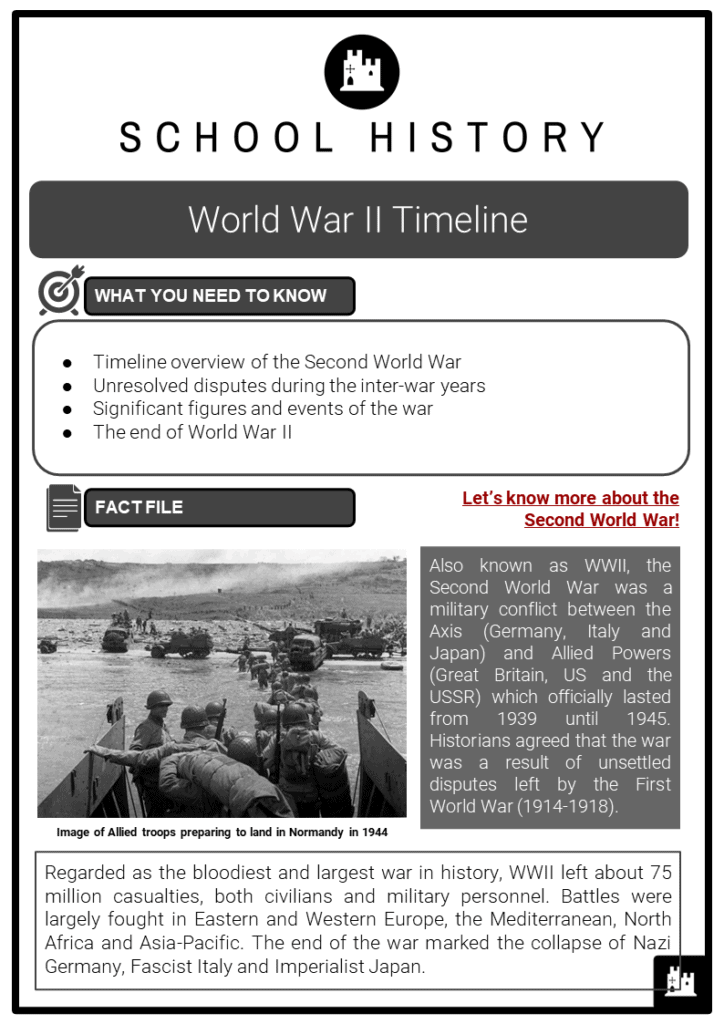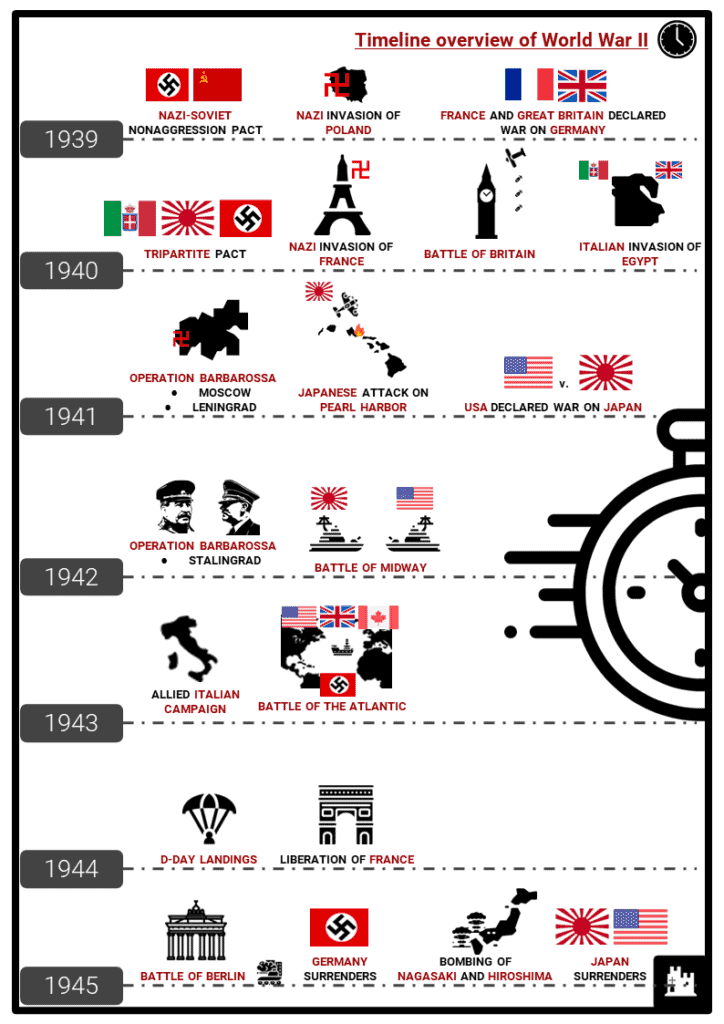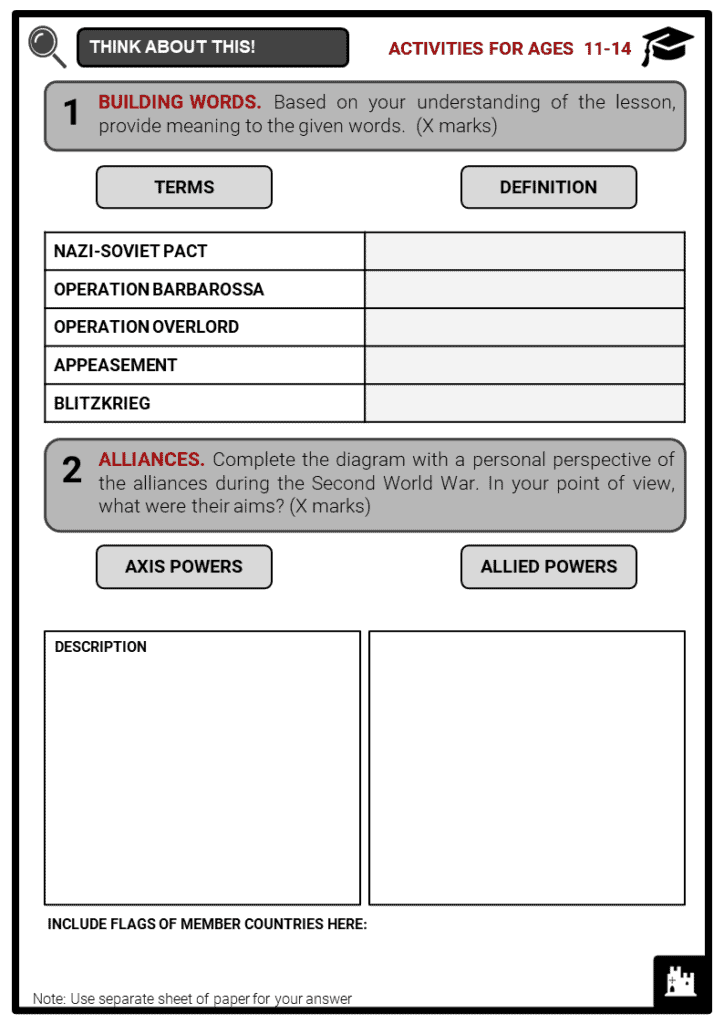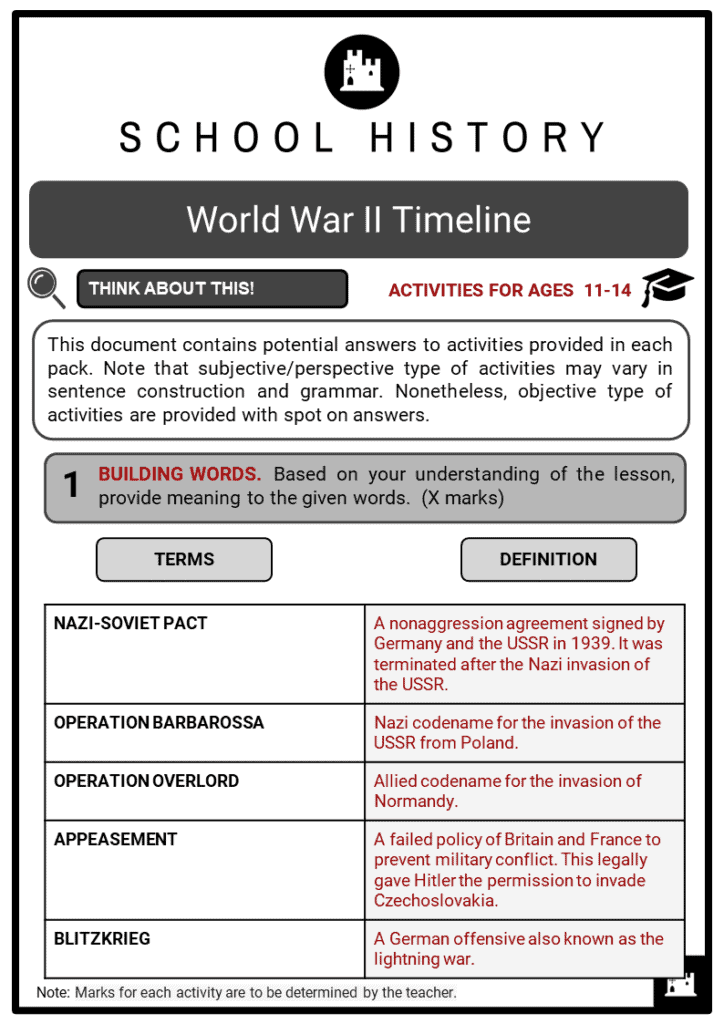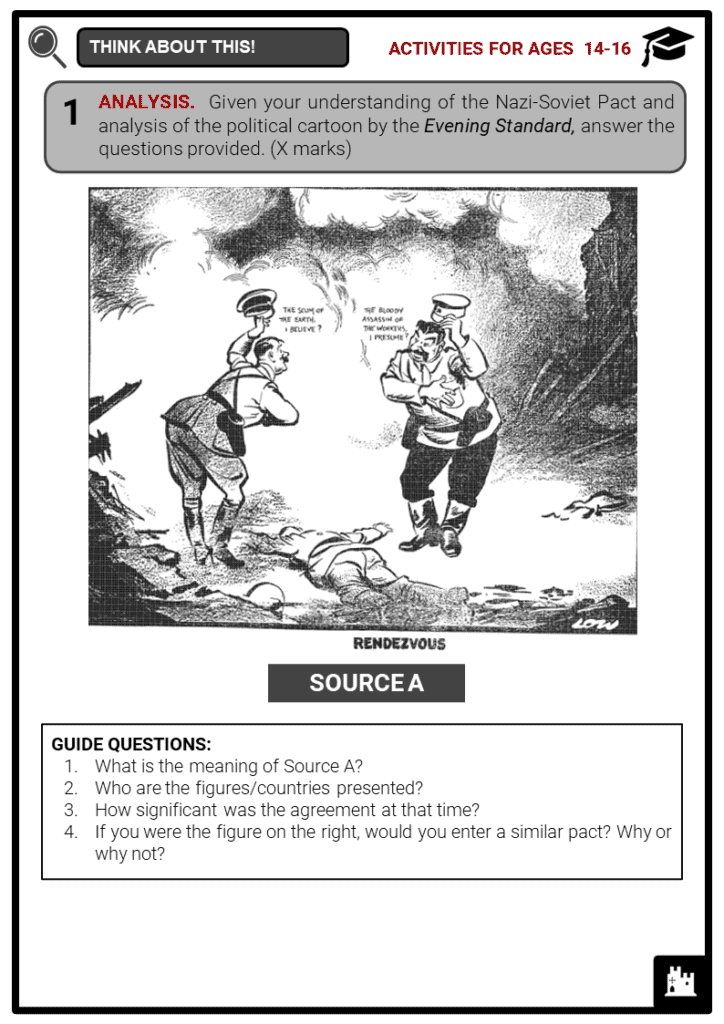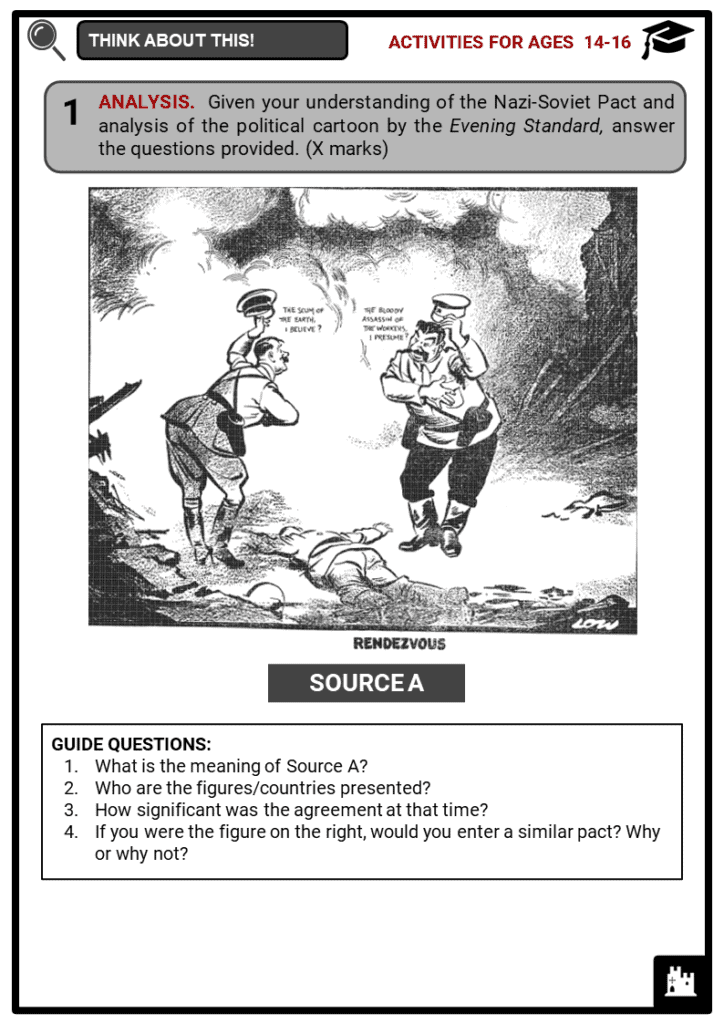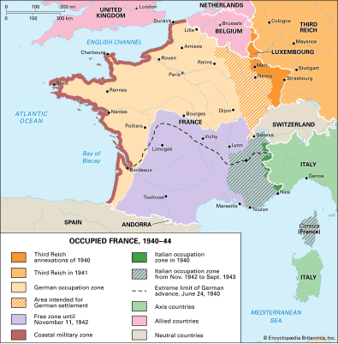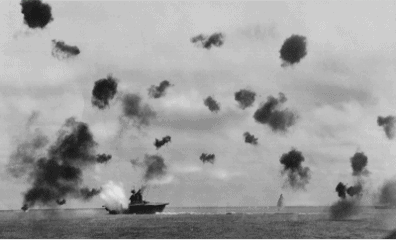Download World War II Timeline Worksheets
Do you want to save dozens of hours in time? Get your evenings and weekends back? Be able to teach World War II Timeline to your students?
Our worksheet bundle includes a fact file and printable worksheets and student activities. Perfect for both the classroom and homeschooling!
Table of Contents
Add a header to begin generating the table of contents
Summary
- Timeline overview of the Second World War
- Unresolved disputes during the inter-war years
- Significant figures and events of the war
- The end of World War II
Key Facts And Information
Let’s know more about the Second World War!
- Also known as WWII, the Second World War was a military conflict between the Axis (Germany, Italy and Japan) and Allied Powers (Great Britain, US and the USSR) which officially lasted from 1939 until 1945. Historians agreed that the war was a result of unsettled disputes left by the First World War (1914-1918).
- Regarded as the bloodiest and largest war in history, WWII left about 75 million casualties, both civilians and military personnel. Battles were largely fought in Eastern and Western Europe, the Mediterranean, North Africa and Asia-Pacific. The end of the war marked the collapse of Nazi Germany, Fascist Italy and Imperialist Japan.
Unresolved disputes during the inter-war years
- Historians suggest that the Second World War was in many respects a continuation of the First World War (1914-1918). During the interwar years, unsettled disputes and tensions over agreements, such as the Treaty of Versailles, led to the outbreak of another war in 1939. Below is a brief timeline of events during the 20 years hiatus of world wars.
- Over the two decades following the end of WWI, the failure of the League of Nations to uphold its mandate in keeping peace and order among its members largely contributed to tensions that led to another world war.
- Moreover, the imperialist ambitions of Japan, Germany and Italy and delay in Allied response made way for an inevitable war.
- Resentment in Germany towards the Treaty of Versailles and Hitler’s promises to make the Aryan race supreme again gave way to the rise of the Nazis.
- In Japan, long-standing conflict against China and Russia over the territories of Manchuria and Korea as well as Western strongholds in several Asian territories contributed to the Japanese ideology of Pan-Asianism.
- Meanwhile, fascist Benito Mussolini had plans to revive the glory of the Roman Empire in the Mediterranean.
- The failure of peace efforts in Europe since the 1920s resulted in the remilitarisation of Germany, disregard of the Treaty of Versailles and unstoppable expansionism.
1939
- Nazi-Soviet Nonaggression Pact
- In August 1939, the Soviets and Nazis signed a nonaggression pact which publicly stated peace and economic ties for ten years. Moreover, the pact also gave Hitler the freedom to invade Poland without USSR interference.
-
- Formally known as the Molotov-Ribbentrop Pact, the agreement between Adolf Hitler and Joseph Stalin enabled both countries to invade Poland. Signed by foreign ministers (Germany) Joachim von Ribbentrop and (USSR) Vyacheslav Molotov, the treaty took effect immediately. On 1 September 1939, Germany invaded Poland. After 16 days, the USSR also entered Poland from the East. The German-Soviet Frontier Treaty was signed which created their new border.
- Nazi invasion of Poland
- Hitler demanded that Danzig be returned to Germany. It was a free city located between Poland and East Prussia at that time and a large number of German-speaking people lived there. It was declared a free city by virtue of the Treaty of Versailles and served as a seaport for Poland.
- France and Britain realised the aggressiveness of Hitler. They vowed to protect Poland in the event of a war. They tried to negotiate with the Soviet Union. However, a difference in political ideologies made the formation of an alliance unlikely. Given the alliance with the Soviet Union, Germany left Poland isolated. In addition, Hitler destroyed any attempt of the Allies at plotting with the Soviets. Most importantly, the Germans gained raw materials from the Soviet Union, which supported its rearmament programme.
- France and Britain declared war on Germany
- On 3 September 1939, WWII broke out when Britain and France reacted to the German invasion of Poland. In around a month, Poland was completely under Nazi control, while Hitler publicly made amends with the Allies. However, Hitler was secretly planning the invasion of France.
- Months before the invasion of Poland, Hitler and Mussolini met British Prime Minister Neville Chamberlain in Munich. After a series of meetings regarding Sudetenland and Czechoslovakia, the leaders came with an agreement. The Czechs saw this as a sign of betrayal and they coined this event the Mnichovský diktát (Munich Betrayal). This event signified the West’s appeasement of Hitler.
1940
- Tripartite Pact
- Germany, Italy and Japan signed the Tripartite Pact, also known as the Berlin Pact, on 27 September 1940. Prior to this, Germany and Japan were already in an alliance agreement in 1936 with the signing of the Anti-Comintern Pact. The Tripartite Pact was the culmination of German, Italian and Japanese alliance and mutual agreements. It specifically urged the signees “to assist one another with all political, economic and military means”. The signatories particularly agreed on the following terms:
- Japanese recognition and respect of German and Italian leadership in Europe.
- German and Italian recognition and respect over Japanese leadership in Greater East Asia.
- Political, economic and military support in case of an attack from powers not involved in the European war or Japanese-Chinese conflict.
- Establishment of technical commissions.
- Agreement between Japan, Germany and Italy would not affect existing political status with Soviet Russia.
- As a defensive military alliance, the Tripartite Pact was soon joined by Hungary (November 1940), Romania (November 1940), Bulgaria (March 1941), Yugoslavia (March 1941), Slovakia (November 1940) and Croatia (June 1941).
- Nazi Invasion of France
- Following the occupations of Denmark, Norway and Luxembourg in early 1940, Hitler invaded France on 10 May.
-
- After six weeks of battle, the German Army defeated the joint forces of Belgium, the Netherlands, France and Britain and captured the French capital city of Paris. Also known as the Battle of France, the fall of France on 10 June 1940 temporarily ended land operations on the Western Front. Through Fall Gelb (Case Yellow), German armoured units were able to push back Allied forces from Dunkirk. By 5 June, the German forces defeated the French and British forces positioned on the Somme and Aisne. By 14 June, with little to no resistance, Paris was occupied.
- On 22 June, French officials and German commanders signed the Second Armistice at Compiègne which created the puppet government at Vichy.
- Battle of Britain
- After the fall of Paris, new PM Winston Churchill knew that the Battle of Britain would soon follow. The British government anticipated that the Nazis would target the capital, London. On the part of the Nazis, Hitler planned to neutralise Britain so he could focus on invading the East, particularly the USSR.
- For the British, the Battle of Britain lasted from 10 July 1940 until 31 October 1940. It is regarded as the first major aerial campaign fought by the Royal Air Force (RAF) and Luftwaffe. In July 1940, the German air force, the Luftwaffe began attacking coastal shipping convoys and ports. This initial campaign was soon followed by direct airstrikes on RAF airfields and infrastructure. The Nazis aimed to incapacitate the RAF Fighter Command to coerce Britain to negotiate.
- On 16 July, Hitler ordered the planning of Operation Sea Lion or the invasion of Britain both from air and sea. This preparation was halted by the night raids launched by the RAF Bomber Command in September. As a result, Hitler suspended Operation Sea Lion but continued with the Blitz.
- Italian invasion of Egypt
- In September 1940, Italy began the invasion of Egypt from Libya (a neighbour of Egypt and an Italian colony for several decades). By December, British-Indian counterattacks defeated the Italians. In response, Hitler decided to aid Mussolini by sending General Erwin Rommel and his ‘Afrika Korps’. At the Battle of El Aghelia in March 1941, Rommel was able to push back Allied forces 160 km east to the Libyan-Egyptian border. By the end of April, the Italian-German force had taken Sollum and Halfaya Pass.
- At the Second Battle of El Alamein in late 1942, the British Eighth Army led by Lieutenant General Bernard Montgomery drove the Axis forces from Egypt to Tunisia.
- In November, through Operation Torch, thousands of British and American forces landed in North Africa and finally crushed the remaining Axis troops in Tunisia in May 1943.
1941
- Operation Barbarossa
- Despite the Nazi-Soviet nonagression pact agreed by Hitler and Stalin, Germany lauched Operation Barbarossa on 22 June 1941. This was a ground offensive attack by Nazi Germany against the Soviet Union during WWII.
- With Pro-Axis armies composed of over 3 million German troops and 1 million others, Nazi Germany launched Operation Barbarossa and began the invasion of the Soviet Union from Poland. Through Directive 21, Hitler ordered the invasion of the USSR. It was initially codenamed Operation Fritz on 15 March 1941, but Hitler renamed it Barbarossa in reference to the 12th-century Roman Emperor Frederick Barbarossa. The Nazi invasion of the USSR began the war on the Eastern Front.
- Soon after identifying the foreign threat, Stalin made himself a Marshal of the Soviet Union, Chief of the Soviet Armed Forces and People’s Commissar for Defence. He named Marshal Georgy Zhukov as Deputy Supreme Commander in Chief of the Soviet Armed Forces. Three months after the Nazi invasion, Stalin made an alliance with Britain and the United States.
- The invasion was due to the following reasons:
- Soviet-controlled Ukraine was valuable land for Nazi crops.
- The Soviet territory of Caucasus was an essential source of oil.
- Soviets would add significant numbers to the German labour force.
- Deportation of Slavic people to Siberia.
- Under Operation Barbarossa, Axis troops moved towards Leningrad, Moscow and Kiev. In mid 1941, the Army Group Centre crossed the Dnieper River to Moscow. This was followed by the capture of Smolensk, a vital stronghold going to Moscow.
- The German strategic plan to invade Moscow was divided into two pincer offensives under codename Operation Typhoon.
- Days after the beginning of Operation Barbarossa, over 1,000,000 German soldiers marched to Leningrad. Hitler planned to invade further into the USSR within a month of capturing Leningrad, but Stalin successfully motivated Soviet citizens to defend the city.
- Through the Lend-Lease Act, American aid of about $11 billion was sent to the Soviet Union. This US-Soviet wartime cooperation ended in September 1945.
- Japanese attack on Pearl Harbor
- In 1940, Japan invaded French Indochina. In response, the United States imposed trade and oil embargoes on Japan, which was viewed as an action of extreme provocation against the Japanese. This act of Japanese expansionism in Southeast Asia alarmed US President Franklin Roosevelt. As a result, he moved the Pacific Fleet from San Diego, California to Hawaii. Moreover, he also positioned a military base in the Philippines. On 7 December 1941, at 7:48 am (Hawaiian time) Japanese aircrafts attacked Pearl Harbor, particularly targeting battleships and aircraft carriers in Oahu. Japan and the United States were still in a middle of a negotiation at the time of the attack.
- The Japanese ‘Striking Force’ was composed of Akagi, Kaga, Sōryū, Hiryū, Shōkaku and Zuikaku ships carrying 408 aircrafts. The Japanese attack on Pearl Harbor took place before any declaration of war with the US.
- Torpedo bombers sunk American battleships immediately. Since it was a Sunday morning, American troops were unprepared. US aircrafts were parked openly, while ammunition lockers were locked.
- The attack of the US Pacific Fleet was materialised by Japanese Admiral Isoroku Yamamoto. It is believed that the attack on Pearl Harbor was to remove any hindrance of completely invading Southeast Asia and the Indonesian archipelago which are rich in natural resources, particularly oil reserves.
- After 90 minutes of Japanese bombing, about 2,008 sailors were killed and 710 wounded; 218 soldiers were killed and 364 wounded; 109 marines were killed and 69 wounded; and 68 civilians were killed and 35 wounded. 18 ships were sunk either by torpedoes or aerial bombs, including 5 battleships. For the Japanese, only about 55 airmen and 9 submariners were killed.
- US declared war on Japan
- In response to the attack on Pearl Harbor, on 8 December, President Roosevelt delivered his Infamy Speech to a joint session of Congress which formally declared war on Japan. Japan insisted that they sent a message to Washington withdrawing the peace agreement prior to the attack, thus not violating any treaties. The ‘14-Part Message’ transmitted from Tokyo was not decoded until the middle of Japanese bombing.
- Nine hours prior to the US declaration of war on Japan, Britain already waged war due to Japanese attacks in Malaya, Singapore and Hong Kong. Two days later, the US also declared war against Germany and Italy.
- Since the official beginning of the Second World War in 1939, the US remained a neutral country. The bombing of Pearl Harbor formally made them part of the war, particularly in the Pacific.
- Despite the casualties and damage caused by the assault, the Japanese failed to totally cripple the island’s onshore facilities, such as oil storage, shipyards, marine docks and repair shops. As a result, the US Navy was able to recover in no time.
- British Prime Minister Winston Churchill even stated that “We have won the war”, referring to the American participation in WWII.
1942
- Battle of Stalingrad
- In the summer of 1942, Nazi Germany’s Wehrmacht forces marched to invade the southern region of the USSR. At the beginning of the German invasion, the Soviets were able to slow down invaders but at a cost of losing over 200,000 men.
- Soviet Generals Georgy Zhukov and Aleksandr Vasilevsky launched a counterattack known as Operation Uranus. Despite heavy losses, the attack was able to trap about 300,000 Germans in the 6th Army.
- In addition to the lack of food supply, the German defeat was also attributed to the extreme winter in Stalingrad.
- Unlike France, the USSR did not suffer from the shock of initial defeats. Instead, nationalism grew among the Soviet people. Moreover, Hitler’s switching from Moscow to Leningrad and Kiev meant Germany’s real chance of victory was missed. When they resumed their campaign on Moscow, the Axis troops were also exhausted.
- By February 1943, Soviet troops recaptured Stalingrad and held almost 100,000 Germans prisoner. Most of them died of starvation and disease in prison camps.
- Determined to keep the war away from the US, President Roosevelt approved the Lend-Lease loan to the USSR on 30 October 1941. The loan was without interest, while payment would start five years after the end of the war. The programme was originally crafted by the US Congress to aid Britain in its war efforts. Despite anticommunist sentiments in the US, the Congress approved the USSR as a recipient of this programme.
- The Soviet victory in the Battle of Stalingrad marked the beginning of the Allied victory.
- It was the first and largest defeat of the German Army that was publicly acknowledged by Hitler.
- Battle of Midway
- Fought in the Pacific theatre, the Battle of Midway was a naval encounter between the Japanese and American naval forces on 3-6 June 1942. Led by Admiral Isoroku Yamamoto, the Japanese Imperial Navy believed that they could finally defeat the US and replicate their victory at Pearl Harbor. A surprise attack was planned by Yamamoto on the US Pacfic Fleet based at Midway Island.
- In early 1942, US Navy cryptanalysts had decoded Japanese communication lines on planning to attack the Pacific at a location they called ‘AF’. Given the information, Admiral Chester Nimitz, commander-in-chief of the US Pacific Fleet, developed a plan.
-
- On 3 June, the US B-17 Flying Fortress bombers mistakenly assumed the Japanese fleet led by Vice Admiral Nobutake Kondo as the main invasion fleet.
- Following the second unsuccessful US attack on Kondo’s force, Vice Admiral Chuichi Nagumo sent four aircraft carriers with 108 warplanes to bombard the US base at Midway Islands. Meanwhile, US torpedo bombers from carriers Hornet and Enterprise were shot down by Japanese Zero fighters.
- While refuelling and rearming, Japanese carriers - Akagi, Kaga and Soryu were bombed by US dive bombers. The last surviving Japanese carrier Hiryu was also set ablaze.
- On 6 June, a Japanese submarine launched torpedoes and sank USS Hammann and Yorktown. On the same day, Yamamoto ordered his navy to retreat.
- By the end of the Battle of Midway, the Japanese lost about 3,000 men, 4 aircraft carriers, 1 heavy cruiser and about 300 aircraft, while the Americans lost Yorktown and Hammann, 360 servicemen and about 145 aircraft.
- This huge loss of the Japanese Imperial Navy halted Japan’s ambition to conquer the Pacific. According to historian Walter Lord, it was an “incredible victory” for the US Navy.
1943
- Allied Italian Campaign
- In January 1943, Allied leaders agreed to invade Italy. They aimed to remove Mussolini from the war and create a diversion for Hitler while they were planning Operation Overlord (invasion of Normandy). In addition to British and Americans troops, the Italian campaign, which lasted from 10 July 1943 until 2 May 1945, was fought by other Allied troops - Algerians, French, Moroccans, Indians, Canadians, New Zealanders and African Americans.
- Operation Husky or the invasion of Sicily was launched on 10 July 1943. The southern shores of the island were invaded by sea and air. Fourteen days later, Mussolini was deposed and arrested. Marshal Pietro Badoglio, who opposed the German alliance and sought Allied armistice, set up a provisional government.
- On 17 August 1943, the Allies failed to capture Italian and German troops in the city Messina.
- Battle of the Atlantic
- Also known as the longest and most complex naval battle in history, the Battle of the Atlantic ran from 1939 until 1945. This naval military campaign peaked between 1940 and 1943.
- The control over the Atlantic Ocean as a vital route in shipping men and supplies from North America and Europe ignited the Battle of the Atlantic. In order to cut this significant supply line, German U-boats and warships began to sink Allied transport ships.
- In addition to the United States and Great Britain, Canada greatly contributed to the battle. Grouped as wolfpacks, German U-boats attacked most Allied merchant ships crossing the Atlantic Ocean. From 30 U-boats in 1939, it increased to 300 in 1942. Between January and July 1942, nearly 400 Allied ships were sunk.
- During the battle, new technology and tactics were developed. Germany developed torpedoes attracted to the sound of propellers, while the Allies came up with a noise-making device to divert these torpedoes. Moreover, a new type of radar technology to detect U-boats was developed by the Allies. Encoding machines used for communications were also upgraded.
1944
- D-Day Landings
- Also known as the Battle of Normandy, the D-Day landings were an Allied invasion to liberate Western Europe from German control. Under codename Operation Overlord, the invasion of Normandy began on 6 June 1944.
- Following the Battle of France, Britain was worried that an invasion via the English Channel was possible. By 1943, Hitler placed General Erwin Rommel to defend the region and build the Atlantic Wall from the coast of France up to Norway.
- In addition to a 2,400-mile fortification of bunkers, Rommel secured the shores with landmines and water obstacles. For the Allied forces, it was an impossible campaign to risk.
- Since 1943, a massive deception operation was planned by the Allies. In January 1944, US General Dwight Eisenhower was appointed as commander of Operation Overlord.
- The Germans believed that the Allied invasion target was Pas-de-Calais (located at the narrowest point in the English Channel). In addition to a fake build-up of troops parallel to Pas-de-Calais, the Allies used dummy equipment, double agents and fraudulent radio transmissions.
- Five hours before the coastal landings, the first ground landing behind enemy lines was made by 13,000 paratroopers and 4,000 glider troops.
- By 6:30am, British, American and Canadian troops landed on five beach points - Utah and Omaha beaches (US), Juno (Canada), Gold and Sword (Britain). Amongst the beach landings, Omaha suffered great casualties. About 2,000 American troops were slaughtered upon stepping ashore in Normandy.
- Liberation of France
- After four years of German occupation, France, particularly the capital of Paris, was liberated on 25 August 1944. On 22 June 1940, after the Battle of France, the Second Compiegne Armistice was signed between France and Germany. This treaty meant there was a German military administration in France seated at Vichy.
- With the ongoing victory in Normandy, Allied leaders including General Eisenhower were not particular in liberating Paris next. Their first priority was to totally crush the German army retreating in the Rhine, and therefore put all efforts on the Pacific. Eisenhower believed that it was too early to recapture Paris which if pursued might lead to a battle of attrition, similar to the Battle of Stalingrad and Siege of Leningrad.
- On 15 August, the French Resistance went ahead with the Allies and staged their own uprising.
- Concerned that his countrymen would be slaughtered, General Charles de Gaulle of the French Army petitioned Allied leaders for an immediate frontal assault in Paris.
- Following Eisenhower’s approval to liberate Paris, the 2nd Armored Division and the 4th Infantry Division advanced to Paris. On the night of 24 August, about 20,000 of the German troops surrendered or fled.
- By the next morning, the western and eastern half of Paris was liberated. Choltitz was arrested on the same day. He signed a document which officially surrendered Paris to de Gaulle’s provisional government.
1945
- Battle of Berlin and German surrender
- Also known as the Berlin Strategic Offensive Operation, the Battle of Berlin was an offensive attack by the USSR between 16 April and 2 May 1945. Historians suggest that even before the fall of Berlin, Germany was already losing the war.
- Following the Vistula-Oder Offensive in January-February 1945, the Soviet offensive resumed with the attack of Berlin from the east and south.
- On the day of Hitler’s birthday, 20 April, Berlin was surrounded by the Red Army. By 23 April, the 1st Ukrainian Front reached inner Berlin. After a week of infiltration, the Red Army took the capital city.
- On 30 April, Hitler and his wife committed suicide. Two days later, the city’s main garrison also surrendered to the Reds. Small and dispersed fightings continued until 8 May. Many German units moved westwards and surrendered to the Allies rather than the Soviets.
- Bombing of Nagasaki and Hiroshima and Japanese surrender
- On 6 August 1945, an atomic bomb was dropped on the city of Hiroshima, Japan. Three days later, on 9 August, another one was dropped on Nagasaki. 60% of Hiroshima’s infrastructure was destroyed. Around 140,000 people were killed in Hiroshima and 74,000 people in Nagasaki. Over the next five years, people died en-masse from the effects of radiation.
- While the destruction of atomic bombs was heard in Tokyo, the USSR declared war on Japan on 8 August. Two days later, the Japanese government agreed to surrender under the terms stipulated in the Potsdam Declaration.
- The Japanese government particularly requested the unaltered sovereign status of Emperor Hirohito.
- On 14 August, Japan agreed on the terms and Emperor Hirohito addressed the Japanese public to surrender. On 2 September, new Prime Minister Suzuki Kantarō survived an attempted assassination by war diehards.
- Also on 2 September 1945, a formal ceremony of surrender took place at USS Missouri in Tokyo Bay. The Allies were generally represented by military leaders MacArthur and Nimitz, while the Japanese sent Shigemitsu Mamoru and Umezu Yoshijiro.
Image sources:

